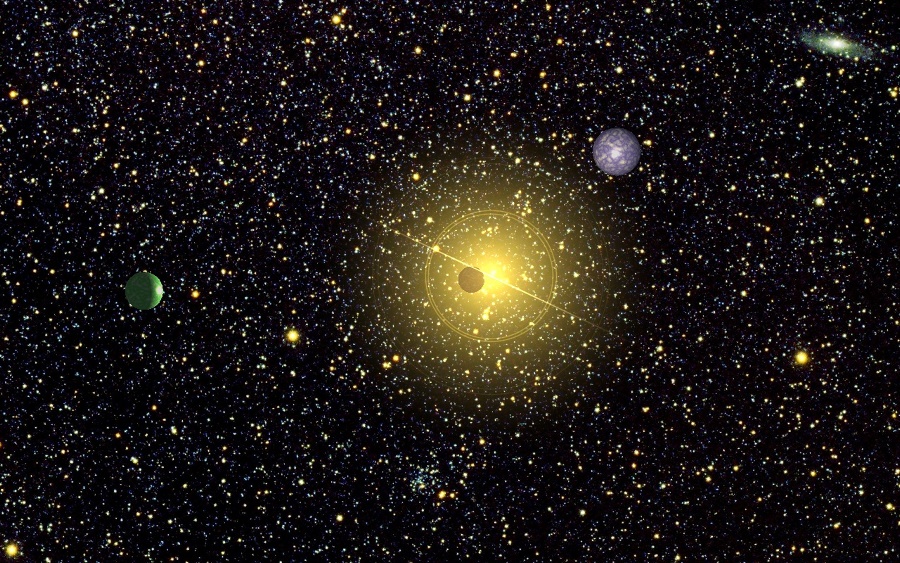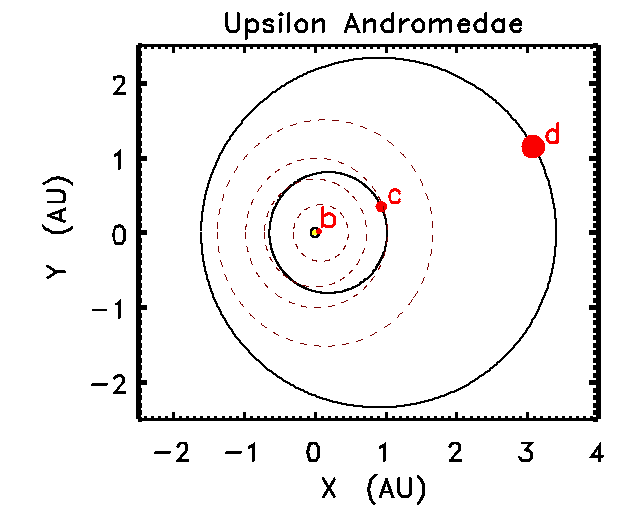|
Extra Solar Planets New Planets Discovered |
||
|
A Triple-Planet System Orbiting Ups Andromedae ...
A
Triple-Planet System Orbiting
Ups Andromedae
A diagram of the orbits of the 3 planets around Upsilon Andromedae. The red dots mark the orbits of planets b,c and d. The dashed circles show the orbits of Mercury, Venus, Earth and Mars to give the scale of the orbits. The Doppler Evidence for Three Planets: The measured Velocities for Upsilon Andreomdae are fit with a model containing three Jupiter-mass companions. The inner planet is subtracted (4.6-day sine wave) to render more visible the wobble caused by the outer two planets.The inner planet
was announced by Butler et al. in Jan
1997. A velocity plot containing a few months of
data looks clean (Fig
1 ), during a few months. However, a larger
duration of velocities
reveals additional velocity variations. Recognizing
that the velocity variations
could be due to a second companion, Butler and Marcy
immediately alerted
the astronomical community to this
possibility.
The second companion appeared to have an orbital period of about 3.5 years from the long-term excursions of the velocities. These velocity variations were also found by the AFOE team of Drs. R.Noyes, T.Brown, S.Korzennik, S.Horner, A.Contos et al. A Keplerian orbital model was constructed to fit the data. However, the best solution still left velocity points scattering above and below the 2-planet theoretical curve. After subtracting the theoretical velocities that would be produced by a 2-planet system from the observed velocities, a periodic pattern was observed in the "residual" velocities, suggesting the possibility of one more companion. A 3-planet model was found to produce a dramtically superior fit to the data, reducing the residual velocities to the expected variations, with no periodicity in the residuals. With the orbital solution for 3 planets that fit our observed velocities, we can subtract the predicted velocities for any one planet, to reveal the velocities caused by the remaining two planets: Similarly, by removing two planets, the velocities vs. orbital phase can be viewed for each companion individually:
Images
of
the Star Field around Upsilon Andromedae.
SOURCE: LICK OBSERVATORY |
||
| FAIR USE NOTICE: This page contains copyrighted material the use of which has not been specifically authorized by the copyright owner. Pegasus Research Consortium distributes this material without profit to those who have expressed a prior interest in receiving the included information for research and educational purposes. We believe this constitutes a fair use of any such copyrighted material as provided for in 17 U.S.C § 107. If you wish to use copyrighted material from this site for purposes of your own that go beyond fair use, you must obtain permission from the copyright owner. | ||
|
|


